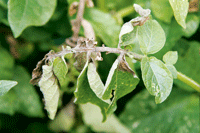Four on-farm steps to integrated blight control

Four on-farm practices have been identified for an integrated control strategy for potato blight, Piet Spoorenberg, a researcher from Wageningen University said at the Endure conference.
But the use of resistant varieties which potentially had the most benefit was currently the least commonly used, he admitted.
The first step was to reduce primary sources of infection, particularly by controlling dumps, he said. “In most years epidemics start from infected plants on dumps, so in the Netherlands there is a regulation to force growers to cover dumps with black plastic, while in the UK the Potato Council’s “Fight against Blight” is used to convince farmers to control infected plants.”
Second, varietal resistance offered a significant potential to reduce fungicide use, because those crops often had lower and later infections.
“But in the EU their use is not common as they don’t meet marketing, yield or earliness goals.”
The third step in an integrated strategy was to use fungicides, which played an important role. “Growers should choose products not only on efficacy but also their side effects on the environment,” he suggested.
The Euroblight website compared products on those criteria, and was available to all growers.
The final step was the use of decision support systems to help spray timings and fungicide choice. “There are a number in use across Europe, which are effective. On average they can save growers one or two sprays a season.”
Genetic engineering to help with varietal resistance
Genetic engineering using genes from related species to potatoes could help produce blight resistant potatoes and overcome social concerns to the technology, Mr Spoorenberg said.
The technique known as cis-genetics allowed researchers to insert blight resistant genes into commercial potato varieties without introducing any foreign gene DNA, he explained. Where foreign DNA, including the bacterial gene commonly used as a marker to test for successful transformations, is inserted the technique is called trans-genetic.
Debate was currently ongoing whether the cis-genetic technique would be more socially acceptable, he said.
“We already have lines to test in fields using the technique. If successful they could reduce fungicide use by 100% potentially.”
More from the Endure conference
IPM case study: Danish grower calls for cost-effective non-chemical tools
Pesticide reduction of 50% achievable in UK
Eurowheat website provides disease control encyclopaedia Endure calls for advisers to join

